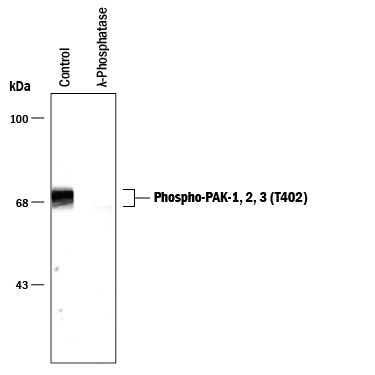Phospho-PAK (T402) Antibody Summary
Applications
Please Note: Optimal dilutions should be determined by each laboratory for each application. General Protocols are available in the Technical Information section on our website.
Scientific Data
 View Larger
View Larger
Detection of Phospho-PAK (T402) by Western Blot. Western blot of rat hippocampal lysate showing specific immunolabeling of the approximately 68-70 kDa PAK protein (Control). The phosphospecificity of this labeling is shown in the second lane ( lambda-phosphatase: lambda PPase). The blot is identical to the control except that it was incubated in lambda PPase (1200 units for 30 minutes) before being exposed to the anti-Phospho-PAK-1, 2, 3 (T402). The immunolabeling of PAK is completely eliminated by treatment with lambda PPase.
Reconstitution Calculator
Preparation and Storage
Background: PAK
PAK (p21-activated kinase) is a general term for a Serine/Threonine kinase that functions downstream of Rho-family GTPases to regulate cytoskeletal (actin) structure and gene transcription. There are two mammalian PAK groups, each with three members. Group I contains PAK-1/ alpha -PAK, PAK-2/ beta -PAK and PAK-3/ gamma -PAK; group II contains PAKs 4-6. All PAKs contain p21-binding domains and a kinase domain. Only group I PAKs are activated by Cdc42 (cell division cycle 24) and exist as dimers. The dimeric form of group I PAKs keep them in an inactive state. This is due to cross-inhibition from one monomer to another. Following p21 binding, these PAKs dissociate and undergo either auto-, or exogenous (PKD1) phosphorylation on a kinase domain Threonine that is embedded in an 18 aa sequence that is absolutely conserved in PAKs 1-3 in both rat and human. In rat, this Threonine occurs at 402 in PAK-2, T422 in PAK-1, and T421 in PAK-3. In human, each position is increased by one (i.e. T403 vs. T402 in rat PAK-2, etc.). Phosphorylation at this homologous site activates the PAKs, which, following additional regulatory phosphorylations, can then interact with desmin, myosin light chain kinase, LIM1, filamin A and/or Merlin. Preparation Prepared from rabbit serum by affinity purification via sequential chromatography
- Bokoch, G.M. (2003) Annu. Rev. Biochem. 72:743.
- Zkumar, R. et al. (2006) Nat. Rev. Cancer 6:459.
- Parrini, M.C. et al. (2002) Mol. Cell 9:73.
- King, C.C. et al. (2000) J. Biol. Chem. 275:41201.
- Chong, C. et al. (2001) J. Biol. Chem. 276:17347.
Product Datasheets
FAQs
No product specific FAQs exist for this product, however you may
View all Antibody FAQsReviews for Phospho-PAK (T402) Antibody
Average Rating: 5 (Based on 1 Review)
Have you used Phospho-PAK (T402) Antibody?
Submit a review and receive an Amazon gift card.
$25/€18/£15/$25CAN/¥75 Yuan/¥2500 Yen for a review with an image
$10/€7/£6/$10 CAD/¥70 Yuan/¥1110 Yen for a review without an image
Filter by:






